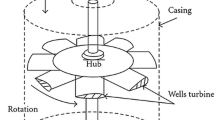Abstract
Wave energy is one of the renewable energy sources with the highest potential. Several pilot plants have been built based on the principle of the Oscillating Water Column (OWC). Among the different solutions that have been suggested, the Wells turbine has gained particular attention due to its simplicity and reliability.
The majority of available studies concentrate on the steady operation of the Wells turbine, while only few analyze its performance under an unsteady and bi-directional air flow, as determined by the presence of the OWC system.
In this work, experimental and numerical performance of a high-solidity Wells turbine with NACA0015 profiles have been compared, at different non-dimensional piston frequencies. The numerical simulations have been conducted using commercial CFD software and focus on unsteady predictions, with particular attention to the behavior of the flow upstream and downstream of the rotor, flow hysteresis between acceleration and deceleration phases and differences between intake and exhaust strokes due to the non-symmetrical configuration of the machine.
Similar content being viewed by others
References
R. Curran and L. M. C. Gato. The energy conversion performance of several types of Wells turbine designs. Proceedings of the Institution of Mechanical Engineers, Part A: Journal of Power and Energy, 211(2): 133–145, 1997.
A. F.d O. Falcao. Wave energy utilization: A review of the technologies. Renewable and Sustainable Energy Reviews, 14(3): 899–918, 2010.
T. S. Dhanasekaran and M. Govardhan. Computational analysis of performance and flow investigation on Wells turbine for wave energy conversion. Renewable Energy, 30(14): 2129–2147, Nov. 2005.
L. M. C. Gato and A. F. de O. Falcao. Aerodynamics of the Wells turbine. International Journal of Mechanical Sciences, 30(6): 383–395, 1988.
L. M. C. Gato and M. Webster. An experimental investigation into the effect of rotor blade sweep on the performance of the variable-pitch Wells turbine. Proceedings of the Institution of Mechanical Engineers, Part A: Journal of Power and Energy, 215(5): 611–622, Jan. 2001.
M. Govardhan and T. S. Dhanasekaran. Effect of Guide Vanes on the Performance of a Variable Chord Self-Rectifying Air Turbine. Journal of Thermal Science, 7(4), 1998.
T. Kim, T. Setoguchi, K. Kaneko, and S. Raghunathan. Numerical investigation on the effect of blade sweep on the performance of Wells turbine. Renewable Energy, 25(2): 235–248, Feb. 2002.
T. Kim, T. Setoguchi, Y. Kinoue, and K. Kaneko. Effects of blade geometry on performance of Wells turbine for wave power conversion. Journal of Thermal Science, 10(4): 293–300, Oct. 2001.
T. H. Kim, T. Setoguchi, M. Takao, K. Kaneko, and S. Santhakumar. Study of turbine with self-pitch-controlled blades for wave energy conversion. International Journal of Thermal Sciences, 41(1): 101–107, 2002.
Y. Kinoue, T. Setoguchi, T. H. Kim, K. Kaneko, and M. Inoue. Mechanism of Hysteretic Characteristics of Wells Turbine for Wave Power Conversion. Journal of Fluids Engineering, 125(2): 302, 2003.
A. Mohamed. Design Optimization of Savonius and Wells Turbines. PhD thesis, Magdeburg University, 2011.
M. H. Mohamed and S. Shaaban. Numerical optimization of axial turbine with self-pitch-controlled blades used for wave energy conversion. International Journal of Energy Research, 38: 592–601, 2014.
M. Paderi and P. Puddu. Experimental investigation in a Wells turbine under bi-directional flow. Renewable Energy, 57: 570–576, Sept. 2013.
P. Puddu, M. Paderi, and C. Manca. Aerodynamic Characterization of a Wells Turbine under Bidirectional Airflow. Energy Procedia, 45: 278–287, 2014.
S. Raghunathan. The Wells air turbine for wave energy conversion. Progress in Aerospace Sciences, 31(4): 335–386, 1995.
T. Setoguchi, S. Santhakumar, H. Maeda, M. Takao, and K. Kaneko. A review of impulse turbines for wave energy conversion. Renewable Energy, 23(2): 261–292, 2001.
T. Setoguchi, S. Santhakumar, M. Takao, T. H. Kim, and K. Kaneko. A modified Wells turbine for wave energy conversion. Renewable Energy, 28(1): 79–91, 2003.
T. Setoguchi and M. Takao. Current status of self rectifying air turbines for wave energy conversion. Energy Conversion and Management, 47(15–16): 2382–2396, 2006.
T. Setoguchi, M. Takao, and K. Kaneko. Hysteresis on wells turbine characteristics in reciprocating flow. International Journal of Rotating Machinery, 4(1): 17–24, 1998.
S. Shaaban and A. Abdel Hafiz. Effect of duct geometry on Wells turbine performance. Energy Conversion and Management, 61: 51–58, Sept. 2012.
R. H. Taylor. Alternative Energy Sources for the Centralised Generation of Electricity. Adam Hilger Ltd, Bristol, 1983.
A. Thakker and R. Abdulhadi. Effect of Blade Profile on the Performance of Wells Turbine under Unidirectional Sinusoidal and Real Sea Flow Conditions. International Journal of Rotating Machinery, 2007: 1–9, 2007.
T. Thorpe. Wave Energy for the 21st century. Status and Prospects. Renewable Energy World, pages 115–121, 2000.
M. Torresi, S. Camporeale, P. Strippoli, and G. Pascazio. Accurate numerical simulation of a high solidity Wells turbine. Renewable Energy, 33(4):735–747, Apr. 2008.
M. Torresi, S. M. Camporeale, and G. Pascazio. Detailed CFD Analysis of the Steady Flow in a Wells Turbine Under Incipient and Deep Stall Conditions. Journal of Fluids Engineering, 131(7): 071103, 2009.
A. Wells. Fluid Driven Rotary Transducer - BR. Pat. 1595700, 1976.
Author information
Authors and Affiliations
Rights and permissions
About this article
Cite this article
Ghisu, T., Puddu, P. & Cambuli, F. Numerical analysis of a wells turbine at different non-dimensional piston frequencies. J. Therm. Sci. 24, 535–543 (2015). https://doi.org/10.1007/s11630-015-0819-6
Received:
Published:
Issue Date:
DOI: https://doi.org/10.1007/s11630-015-0819-6




